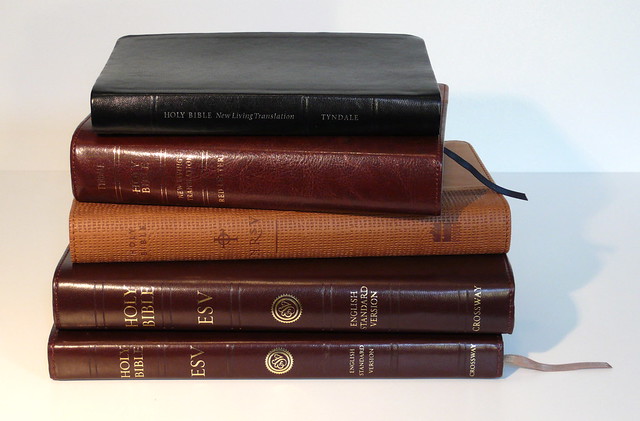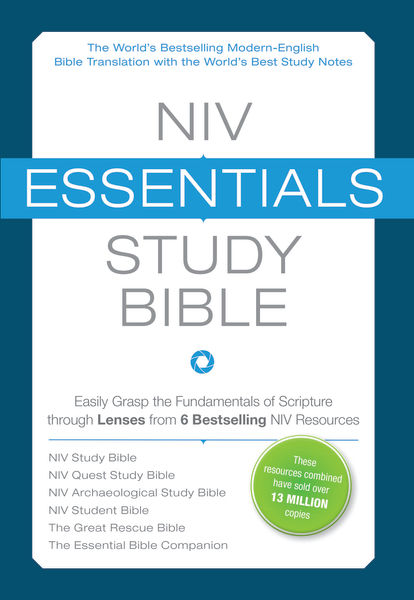
I’ve found that one of the key elements when it comes to reading through and understanding the Bible has been to have a good study Bible that is filled with helpful footnotes, explanations and cross-references. (Here's a review of the study Bible I use, as well as a review of the study Bible that my husband uses.)
This past year, I got the chance to receive a handful of study Bibles to add into my quiet times, so that I could share my thoughts and experiences with you this year. There are a ton of different study Bibles out there, and my hope is that by getting to compare a couple, you might be able to find the perfect one for you (or at the very least, a good addition to your Bible-study library!).
Here's a look at three of the new study Bibles that I got to try out this year that I loved the best:
 Chronological Life Application Study Bible (NLT)
Chronological Life Application Study Bible (NLT)Interspersed throughout are really in-depth profiles, illustrations and explanations about things like specific characters (Hezekiah), places (Solomon's temple) or even just interesting details, such a photograph of the Appian Way, a main highway during the days of Paul that he likely traveled. It pulls in lots of archeological facts, information, full-color photographs and maps that really help you wrap your head around the history of it all. (I should point out that I loved the fact that this Bible was printed in full color; the pages are heavier to accommodate that, so you don't feel like you're going to rip them with every turn.)
Then, along the top of the pages runs a timeline, showing you during what Biblical "era" (such as during the Birth of Israel or its Exile or once its Return & Diaspora) the section you are reading occurred. Finally, as with any study Bible, littered along the bottom of the pages are specific insights about specific verses. It is not exhaustive—there were still times I was left wondering about what a certain passage meant—but it is very helpful.
The biggest drawback is that it is not a Bible friendly to flipping through (so probably not good for Sunday morning services unless you'll only be staying in one spot in Scripture); the passages are scattered about depending on the chronology so it's harder to locate a passage without going to the directory in the front of the Bible. That being said, I loved this Bible (it was my hands-down favorite of the three) and think it is incredibly handy and insightful for bringing the historical and cultural elements of the Bible to life during your daily quiet times.
NIV Essentials Study Bible
Even though it pulls from all these different resources, it doesn't pull everything from each one; so it isn't exhaustive and you'd still likely find yourself wanting to purchase one of the specific ones to get it's full benefit. That being said, if you don't know what kind of study Bible you want, this can be useful to gauge that or simply to provide a variety to your studies. I do think it provides more in-depth info and call-outs than your standard study Bible, making it a solid resource.
 Compass: The Study Bible for Navigating Your Life
Compass: The Study Bible for Navigating Your LifeSo sometimes a word may not be in the original text and would have been implied, but in our modern texts we'd leave it out since it wasn't there; The Voice will add it back in to aid comprehension, but in italics so that you're aware of the addition. I found that this really did help me understand a text, in context, without having to jump around or stop to read footnotes.
Another element of The Voice is that any dialogue is written in screenplay format that identifies the speaker but then eliminates the repetition of things like "then he said" that can clutter up a text. It took some getting used to, but I did find it made larger dialogue texts much easier to follow along with. Finally, they integrate additional explanatory text into the text as sidebars; so for example, in Proverbs, there's a call-out that explains that many of the proverbs are written in a Hebrew poetic form known as parallelism.
At first I didn't think I would like how everything was integrated into the text directly, but I have found that it really does make reading and understanding the text much easier when you don't have to jump around for explanations and insights. The only drawback is that other study Bibles (such as the other two I've reviewed here) are able to incorporate more information and details. Still, I oftentimes find myself reaching for this one first when I'm reading a text to get a really solid understanding of the text first, and then using the others to provide additional insights that bring the text to life even more.
{ photo source }






No comments:
Post a Comment
Note: Only a member of this blog may post a comment.